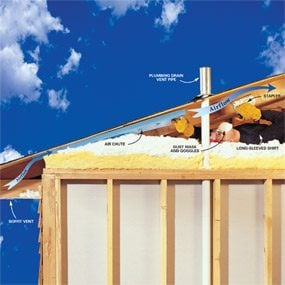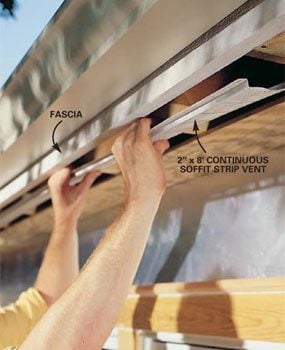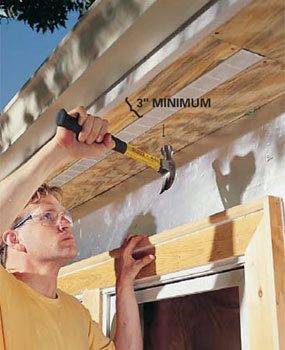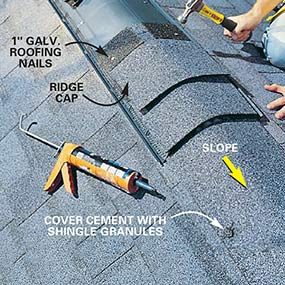how to install soffit vent
Improve Attic Ventilation: Introduction
A well-ventilated attic makes for a healthier house. Here's how to keep the air moving with soffit vents.
 Family Handyman
Family Handyman
Roof and soffit vents reduce cooling costs in summer, prevents ice dams in the winter, extend the life of your shingles and prevent mildew and rot by reducing moisture buildup. Learn how to install them in this article.
You might also like: TBD
- Time
- Complexity
- Cost
- Multiple Days
- Beginner
- Varies
A well-ventilated attic offers four benefits
- It prevents mildew growth and rot on your roof's framing and sheathing by reducing moisture buildup.
- It helps prevent ice dams in winter by keeping your roof colder.
- It extends the life of your shingles by keeping the roof cooler in hot weather. (The manufacturer's shingle warranty usually requires ventilation.)
- It reduces cooling costs in the warm season. The savings will be slight if you have a well-insulated attic space; greater if you have little insulation.
In this article, we'll tell you when you need additional ventilation, how to install several types of passive roof vents and soffit vent covers, and how to keep your ventilation system working. We won't cover fan-powered ventilation, since this type is usually not necessary.
As you will see, improving attic ventilation isn't expensive, time-consuming or difficult, even for the novice. You only need basic hand and power tools. However, when you climb up on your roof, be sure to follow safety precautions.
CAUTION!
Asbestos has been found in some types of vermiculite insulation. Vermiculite, a lightweight material resembling gravel, was used as attic insulation in perhaps as many as a million homes. If you have vermiculite in your attic, don't disturb it unless you have a sample checked by an accredited laboratory. Disturbing it can release the asbestos fibers, which, once airborne, can enter your lungs and eventually cause lung disease. For a list of accredited testing labs, call your local department of public health. For more vermiculite details, go to the Environmental Protection Agency (EPA) (www.epa.gov) or call your regional EPA office.
Does your house need more vents?

Photo 1: Add air chutes
Install air chutes in each rafter space to keep the air path clear between the rafters and the roof sheathing. (Tip: Coat your arms, face and neck with talcum powder to reduce the itching from insulation.) Staple the chutes in place. Be sure to wear long sleeves, goggles and a dust mask. In some cases you may need to install a "wind wash barrier" of wood or plastic to close the gap between the top plate and the air chute, to prevent wind from blowing into the attic. Consult your local building inspector for more information.

Photo 2: Seal penetrations
Seal gaps around plumbing drain vent pipes, ductwork and electrical boxes with minimal-expanding foam or caulk. This helps keep warm, moist air out of the attic.

Photo 3: Clean soffit vents
Clear your soffit vents every few years with blasts of compressed air. Always do this to your soffit vents after you install air chutes because you'll probably knock insulation down into the soffit.
Before you go out and start poking holes in your roof and soffits, check to see if you have the type of problem that attic ventilation can solve.
One common problem is caused by ice buildup along the edges of a roof. These ice dams form when warm attic air melts the snow on the roof and the water refreezes along the colder edge of the roof. The ice traps water behind it, allowing the water to seep back under the shingles and leak through the roof. Increased ventilation will make the entire roof cold and reduce or eliminate ice dams. Here's what you can do to prevent ice dams.
Another common problem is moisture buildup. After cold weather arrives, grab a flashlight and inspect your attic. Cover all your skin to protect it from the itchy insulation, and wear a dust mask. If your attic doesn't have a walkway, take two small (2 x 4 ft.) sheets of 1/2-in. plywood to move around on.
Here are the signs to look for:
- Frost on the underside of the roof or rafters. Warm, moist air trapped in the attic condenses and freezes on the wood.
- Water-stained or blackened wood. A sign of mildew or rot. You can also spot this in the summer.
- Heavily rusted nails. A sign that condensation is forming on metal surfaces.
- Matted-down insulation. A sign of roof leaks from ice damming or other causes.
If you have either ice dams or moisture buildup, improve your attic ventilation. Begin by making sure your existing system works (Photos 1 and 3), plugging major air leaks into the attic (Photo 2) and correcting any other of the common causes of poor attic venting. If those steps don't solve the problem, add more soffit vents, following the techniques we show in Photos 4 – 17. For help figuring how much venting you need, see "Minimum Venting Requirements," below.
Even if you aren't having problems, bring your attic venting up to code when (1) you install new shingles and (2) you add attic insulation.
Five Common Causes of Poor Attic Venting
Problem 1: Insulation often clogs the space between the rafters, blocking air from traveling to and from the soffit area. Solution: Install air chutes or clear them if they're clogged (Photo 1).
Problem 2: Aluminum or vinyl soffits (eaves) installed over plywood soffits that don't have venting holes. Solution: Cut holes in plywood soffits as needed.
Problem 3: Gaps to the attic around plumbing pipes, ducting and electrical boxes. Many experts consider plugging these holes to be more important than ventilation. Solution: See Photo 2.
Problem 4: Rectangular roof vents installed on one side of the roof only. Rectangular roof vents work best when the wind blows over the top of them, rather than into them. Solution: Install rectangular roof vents on both sides of the roof.
Problem 5: Kitchen and bath fans vented into the attic. Solution: Vent these fans through the roof or soffit.
Add soffit venting first

Photo 4: Mark holes for soffit venting
Butt a cardboard template against the fascia and mark your soffit hole locations to begin soffit vent installation. Make the vent hole 1/2 in. smaller on each side than the vent you're installing. If you widen existing holes, widen them toward the fascia, but no closer than 3 in. from the fascia to avoid waves and ripples in the soffit plywood. Position the soffit venting holes between the rafters at equal intervals. You can find the rafters by locating the nailheads or using a stud finder. You can also try installing maintenance-free aluminum soffit vents, too.

Photo 5: Cut the soffit vent hole
Drill 3/8-in. starter holes at opposite corners of the soffit vent hole. Then cut out the hole with a jigsaw. If the soffit plywood begins to tear and splinter in the crosscut, use a utility knife to score the cutting line.

Photo 6: Install the soffit vent covers
Install the soffit vent covers with self-tapping screws. Angle the soffit vent louvers toward the house wall. This prevents blowing snow from entering the soffit vent, and it looks better from the ground.

Photo 7: For more airflow, install continuous soffit vents
Install a 2-in. continuous soffit vent strip so that it's closer to the fascia than to the house wall. Loosely nail one side of the soffit, then slide the strip vent's flange underneath the plywood.

Photo 8: Nail the plywood strips
Finish nailing up the strips. The narrowest soffit plywood strip should be at least 3 in. wide.
You can gain the most airflow with the least amount of trouble by installing soffit vents. The two most common are rectangular vents (Photo 9) and continuous soffit vent strip vents (Photo 7). Continuous strip soffit vents allow perfectly even ventilation along the eaves (Photos 7 and 8), but they're difficult to retrofit in an existing soffit.
Rectangular vents are the easiest to install (Photos 4 – 6). In our project, we replaced all our 4 x 16-in. vents (28 sq. in. of net free vent area, or NFVA) with 8 x 16-in. vents (56 sq. in. NFVA) and added more. This increased our soffit ventilation almost five times. An 8 x 16-in. vent takes less than 10 minutes to install.
Minimum Venting Requirements
Most building codes require 1 sq. ft. of venting (technically, "net free vent area, " or NFVA) for each 150 sq. ft. of attic. In some circumstances you can have less, but we recommend the 1:150 ratio. So a house with a 1,500-sq.-ft. attic will need 10 sq. ft. of venting, ideally about half placed high on the roof and half in the soffits. Look for the NFVA of each vent you buy stamped somewhere on the metal.
Rectangular roof vents

Photo 9: Cut a hole in the roof
Cut a square hole in the roof the same size as the hole in the base of the vent you're installing. Locate the top of the hole about 15 in. below the peak of the roof. Mark the hole with chalk and set your saw depth to cut through the shingles and the roof sheathing only. Don't cut into any rafters. For a roof with a single layer of shingles, start with a depth of 3/4 in. Use an old carbide blade for cutting, and wear safety goggles and hearing protection because you WILL hit nails.

Photo 10: Trim the shingles
Measure the vent hood size and trim the topmost shingles with a hooked knife blade so they will butt against the vent hood on the top and the sides. You'll have to trim two or three rows of shingles (see Photo 12).

Photo 11: Pry out nails
Pull nails as necessary so the vent's flange can slide into place. The best time to do this is when the shingles are cool (early morning). Use your flat pry bar to carefully separate the shingles from one another. Apply roofing cement around the perimeter of the hole.

Photo 12: Push the vent under the shingles
Hold the vent up at an angle and slide it into place. Then set it down into the roofing cement.

Photo 13: Nail the vent down
Nail the flange to the roof on the front edge. Finish sealing the vent by applying cement to the areas where the shingles overlap one another and where they overlap the flange.
Rectangular metal roof vents work best on hip or pyramid roofs that have a short ridge line. Look for galvanized steel vents (available at roofing supply stores and some home centers). Follow Photos 9 – 13 for installation tips. Consult a roofing supply store for special installation instructions if you have a metal, slate, cedar or tile roof. Ever wonder if a turbine vent is better or if a flat roof vent is the best? Here's the answer.
Roof Safety Tips
Tip 1: Use a safety harness (see Photo 9), especially if your roof has a slope steeper than 6:12.
Tip 2: Work only when the roof is dry. Wet shingles can be slippery.
Tip 3: Keep your shoe soles flat on the roof, rather than digging in with the edges.
Tip 4: After making cuts with your circular saw, sweep away the sawdust to avoid slipping.
Tip 5: Don't step on power cords or ropes. They'll roll under your feet and cause a fall.
Ridge vents

Photo 14: Mark the cuts on both sides of the ridge
Remove the old ridge cap with a flat pry bar or square-nose shovel. Pull out any nails left behind. Use a chalk line to mark your cutting line. First, pop a line along the very top of the ridge. Then pop a line 1-1/2 in. down from your ridge line on both sides of it. These will be your cutting lines.

Photo 15: Wear safety gear when you cut the slot
Cut out a slot in the shingles and the sheathing with a circular saw equipped with an old carbide blade. For a single shingle layer, start with a blade depth of 3/4 in. and make sure it doesn't cut into the rafters. If you have an overhang, stop the slot short so the opening is only over the attic space, not the overhang. If you have a hip roof (no gabled ends), stop the slot 6 in. short of the beginning of the hip. Wear your goggles and hearing protection because you WILL hit nails. Sweep off the sawdust and open the slot with a flat pry bar.

Photo 16: Nail the vent down
To install the ridge vent, first pop a chalk line down from your ridge line that's equal to half the width of the ridge vent. Then align the ridge vent pieces. Nail one side of the vent in place with 2-1/2 in. galvanized nails. To keep the line straight, finish nailing the side you aligned with your chalk line before nailing the other side.

Photo 17: Shingle over the vent
Cover the vent with ridge cap shingles using 1-in. galvanized roofing nails. The vent will have a nail line marked on it. You can buy special ridge cap shingles for laminated shingles like we show here, or cut your own ridge cap from three-tab shingles (the shingle packaging will have directions). If you have to stop the ridge vent short of the end of the ridge, install the remaining ridge cap so that it slopes away from the vent.
Ridge vents with attic vent baffles have several advantages: Their low profile and shingle cover make them blend into the roof, and they distribute ventilation evenly along the ridge. You're also less likely to damage the shingles when you install them.
Ridge vents are available from roofing dealers and many home centers. Follow Photos 14 – 17 for installation tips.
3 Specialty Vents
Figure A: Starter Vent
If your house doesn't have soffits or overhangs and the roof stops at the wall, you can vent the lower edge of your roof with "starter" vent (also called "drip edge vent"). To install it, remove the first few rows of shingles and cut away the leading edge of your roof sheathing and the top edge of your fascia. Available from roofing supply stores.
Figure B: Circular Vents
These vents, available in 2-, 3- and 4-in. diameters, are ideal if you have eaves but no soffits. Install them by cutting holes into the blocking between the exposed rafter tails and pressing the vents into the holes. Make sure the airflow has a clear pathway through the insulation. Available at roofing supply stores and well-stocked home centers.
Figure C: Flash Filter Vent
This vent works where a roof meets a wall. Available from roofing supply stores. (Note: Rectangular roof vents often work in these situations as well.)
Required Tools for this Project
Have the necessary tools for this DIY project lined up before you start—you'll save time and frustration.
Required Materials for this Project
Avoid last-minute shopping trips by having all your materials ready ahead of time. Here's a list.
Similar Projects
how to install soffit vent
Source: https://www.familyhandyman.com/project/improve-attic-ventilation-introduction/
Posted by: silveirawellegly.blogspot.com

0 Response to "how to install soffit vent"
Post a Comment